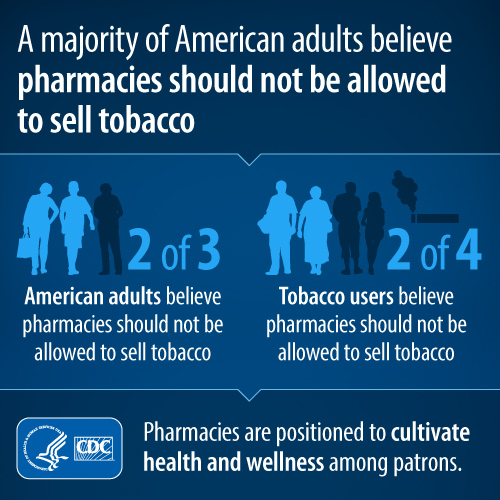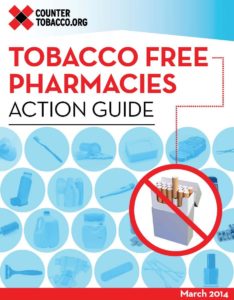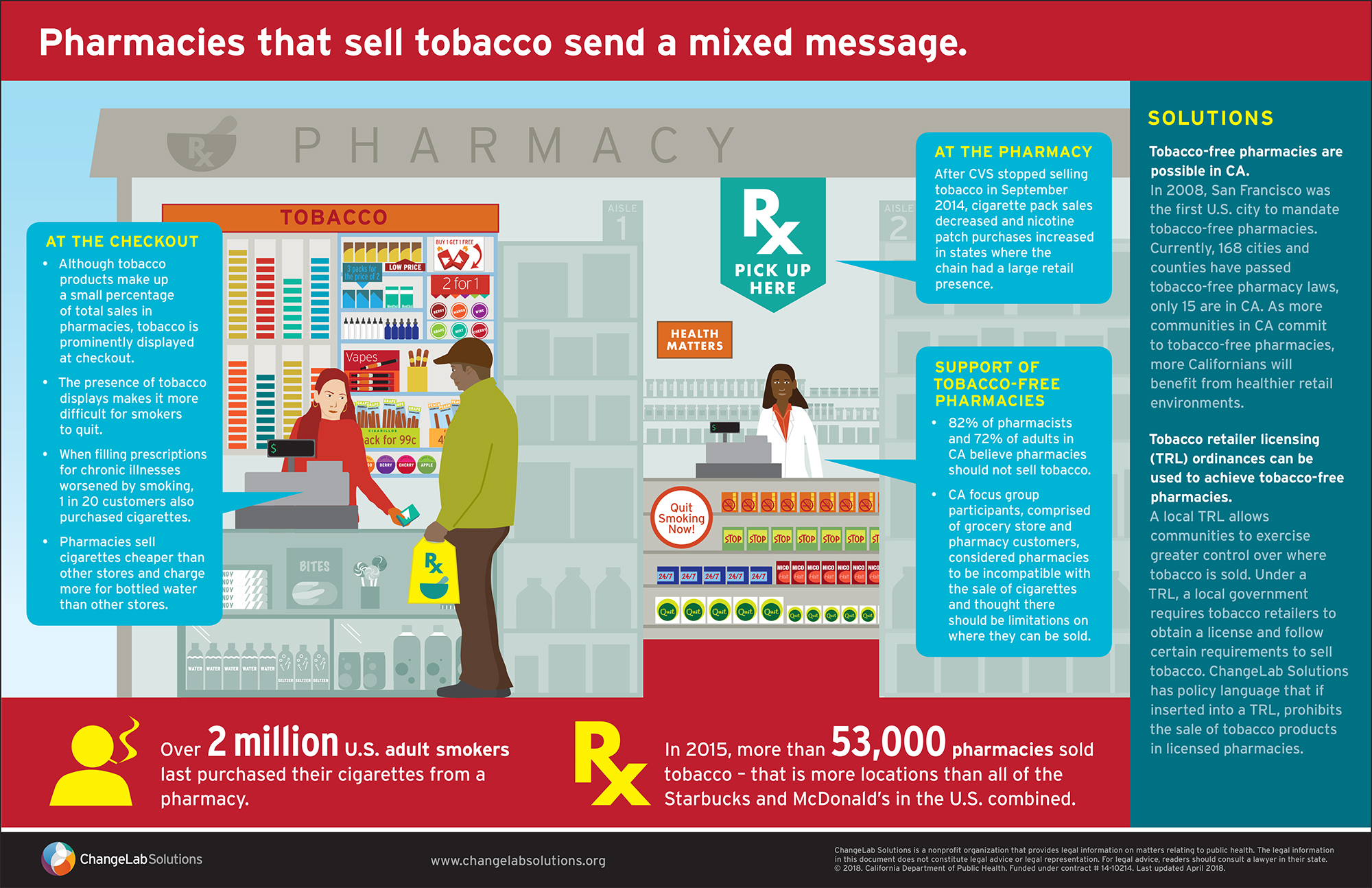Tobacco Free Pharmacies
Selling tobacco in pharmacies sends a mixed message to consumers about the dangers of tobacco products, makes it harder for people who smoke to quit, and is a conflict of interest for pharmacists.
 Despite the known health risks of tobacco, pharmacies represent nearly 5% of cigarette sales, and while cigarette sales declined nationally by 17% between 2005-2009, cigarette sales increased in pharmacies by 23% during this time.[1] In addition, studies have shown that cigarettes in pharmacies are actually cheaper and more often discounted than at other stores.[2, 3] However, research shows that pharmacists[4,5,6] and the overall public[7,8] overwhelmingly support removing this deadly product from pharmacies. A 2014 survey showed two-thirds of Americans would support a ban on tobacco sales in pharmacies, including nearly half of people who smoke.[9]
Despite the known health risks of tobacco, pharmacies represent nearly 5% of cigarette sales, and while cigarette sales declined nationally by 17% between 2005-2009, cigarette sales increased in pharmacies by 23% during this time.[1] In addition, studies have shown that cigarettes in pharmacies are actually cheaper and more often discounted than at other stores.[2, 3] However, research shows that pharmacists[4,5,6] and the overall public[7,8] overwhelmingly support removing this deadly product from pharmacies. A 2014 survey showed two-thirds of Americans would support a ban on tobacco sales in pharmacies, including nearly half of people who smoke.[9]
In 2008, San Francisco became the first city in the U.S. to ban tobacco sales in pharmacies, and 42 other municipalities in California have followed suit as of October 2021.
Also in 2008, Boston became the the second city in the U.S. to ban tobacco sales in pharmacies. Over the following 10 years, over 170 cities and towns in Massachusetts enacted similar bans, and in July 2018, Massachusetts became the first state to prohibit the sale of tobacco products at pharmacies, hospitals, or other healthcare institutions.
In 2013, Rock County, Minnesota passed an ordinance preemptively prohibiting tobacco sales in pharmacies (as the town did not have any pharmacies at the time).
In February 2017, Rockland County, NY became the first community in the state of New York to ban tobacco sales in pharmacies, followed by New York City in August 2017, Albany County in May 2018, Erie County in December 2018, and Suffolk County in April 2019. In April 2020, New York became the second state to prohibit the sale of tobacco products in pharmacies.
The Evidence for Tobacco-Free Pharmacies
Prohibiting tobacco sales in pharmacies reduces tobacco retailer density. This has been seen in the states of Massachusetts and California, where cities that banned the sale of tobacco in pharmacies saw a three times greater reduction in retailer density compared to cities that did not.[10] In North Carolina, a study examining the relative effectiveness of policies in reducing the number and density of tobacco retailers in the state found that a ban on tobacco sales in pharmacies would reduce retailers in the state by over 1,000 and reduce density by 13.9%.[11] New York City’s policy is predicted to decrease retailer density by 6.8% across the city and by up to 15% in some neighborhoods.[12] While the steeper decreases in density in NYC will be seen in largely higher-income, white neighborhoods,[12] tobacco-free pharmacy policies can be paired with other retailer restrictions, such as neighborhood-based retailer caps, as NYC is also implementing, or restricting stores near schools, which can help reduce income- and race-based disparities in retailer density.[13] Learn more about these complementary strategies here.
Removing tobacco sales from pharmacies can encourage users to quit. In February 2014, CVS announced its decision to stop selling tobacco products, becoming the first retail pharmacy chain in the U.S. to take such action. Following the chain’s removal of tobacco products from its stores, total cigarette purchases in states where CVS holds significant market share declined by 1%, and people who smoke and had previously purchased their cigarettes exclusively at CVS were up to twice as likely to stop buying cigarettes entirely.[14] In addition, during the two years after CVS quit selling tobacco, quit attempts increased by 2.21% among people who smoke and live in counties with a high density of CVS stores compared to people who smoke and live in an area with no CVS stores.[15] While Walgreens still sells tobacco products, a 2018 Truth Initiative survey of their customers found that 73% would support the pharmacy chain following CVS’s lead and ending tobacco sales. In addition, 64% said they would shop at Walgreens just as often if they ended tobacco sales and 27% said they would shop there more often. Surveys of employees at Walgreens and CVS locations in San Francisco (where a tobacco-free pharmacy policy is in place) and in San Jose (where tobacco sales are still allowed in pharmacies) were conducted in 2017. Researchers found that while 70% of employees at pharmacies that sold tobacco worried that ending tobacco sales would reduce the number of customers coming to the store, the majority (55%) of employees at tobacco-free pharmacies said that the policy had not affected customer visits.[16]
Like many other types of retailer, pharmacies also have been found to illegally sell to underage youth. One study conducted between 2012-2017 found that Walgreens sold to minors during an FDA visit about 1 out of every 10 times, while other pharmacies chains had violation rates ranging from 4.2% to 7.6%.[17] In 2019, the FDA issued a warning letter to Walgreens for repeatedly selling tobacco products to underage youth, with an overall violation rate of 22% since FDA inspections began in 2010.
We know that higher prices for tobacco products are effective strategies at reducing initiation, decreasing consumption, and increasing cessation. However, some evidence shows that prices for tobacco are actually lower at pharmacies than at other types of tobacco retailers. A study conducted in 2014 in California found that cigarettes were $0.46 to $1.19 cheaper at pharmacies compared to other stores.[18] Another study found pharmacies across the country were more likely than other types of tobacco retailers to offer discounts on tobacco, with 94% of pharmacies offering promotions compared to 82% of convenience stores and 77% of tobacco stores.[19]

Learn more about Massachusetts’ success in ‘Regulating Pharmacy Tobacco Sales: Massachusetts,’ the second case study in the Innovative Point-of-Sale Policies series from the Center for Public Health Systems Science at Washington University in St. Louis.
Some smaller chains and many independent retailers, such as the ones from Vermont featured in the video below, have also chosen to stop selling tobacco products. In fact, according to Counter Balance, 98% of independent pharmacies in Vermont are now tobacco-free. Learn why:
 CounterTobacco.Org developed the Tobacco Free Pharmacies Action Guide in collaboration with tobacco control stakeholders across the country. Prohibiting the sale of tobacco in pharmacies can be an important piece of a community’s overall point-of-sale tobacco control plan. The Tobacco Free Pharmacies Action Guide provides recommendations and tools to help tobacco control advocates build support and develop a policy to prohibit the sale of tobacco products in pharmacies.
CounterTobacco.Org developed the Tobacco Free Pharmacies Action Guide in collaboration with tobacco control stakeholders across the country. Prohibiting the sale of tobacco in pharmacies can be an important piece of a community’s overall point-of-sale tobacco control plan. The Tobacco Free Pharmacies Action Guide provides recommendations and tools to help tobacco control advocates build support and develop a policy to prohibit the sale of tobacco products in pharmacies.
More Resources
- Infographic: Pharmacies that sell tobacco send a mixed message, ChangeLab Solutions:
- Prohibiting the Sale of Tobacco Products in Pharmacies, Public Health Law Center
- A Prescription for Health, ChangeLab Solutions
- Tobacco Free Pharmacies Plug-In for the Tobacco Retailer Licensing Model Ordinance, ChangeLab Solutions
- Model Ordinance Prohibiting the Sale of Tobacco and Unregulated Nicotine Delivery Products by Healthcare Institutions, Americans for Nonsmokers’ Rights
- ShopTobaccoFree.org, Campaign for Tobacco Free Kids
- TobaccoFreeRx.org



